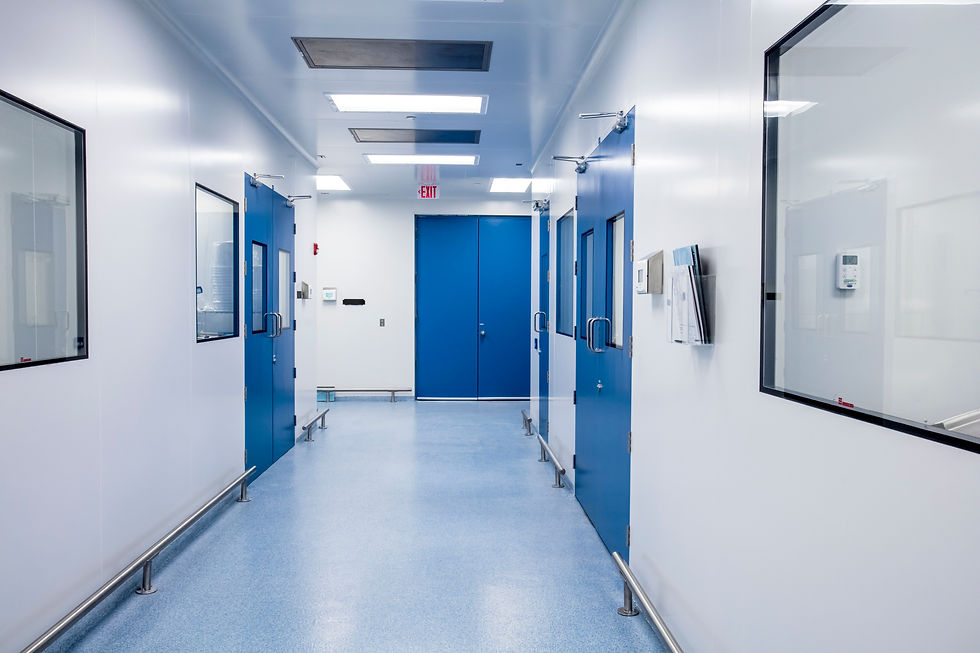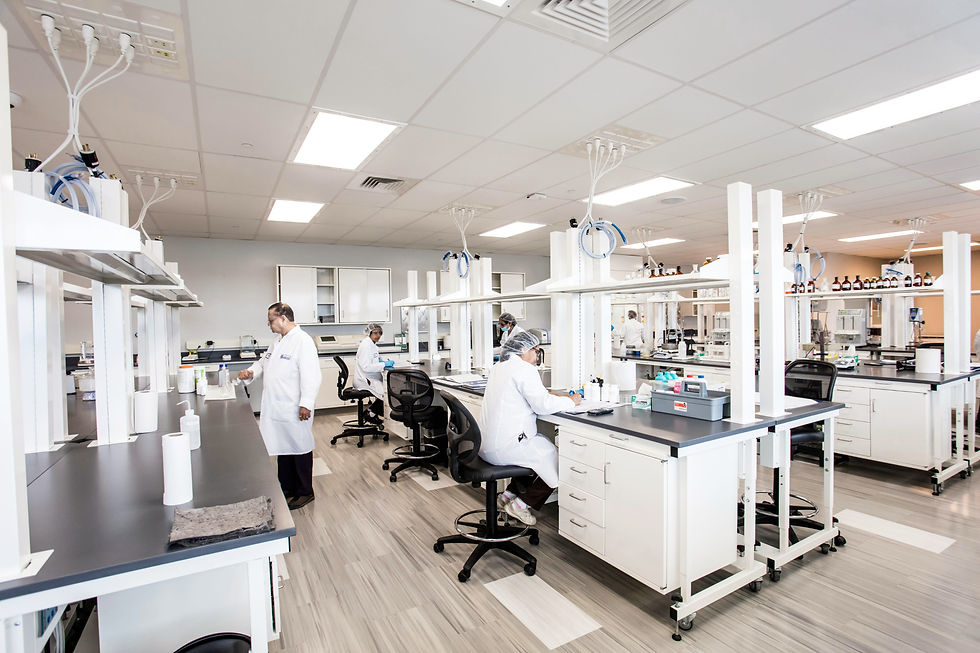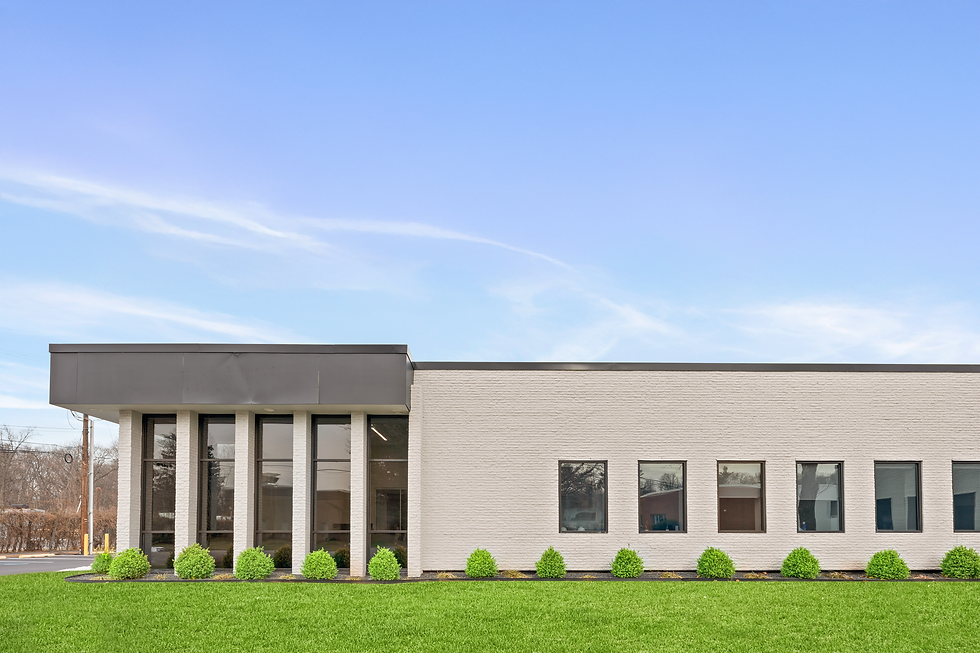2025 Life Science Outlook | Market and Design Insights
- Ishita Kachru
- Aug 7, 2025
- 4 min read
Updated: Aug 12, 2025
Designing for Demand: Fast, Flexible, and Future-Ready Labs.

The U.S. life sciences industry is facing unprecedented challenges in 2025 due to newly introduced tariffs on pharmaceutical imports. These tariffs, which begin at modest levels and could rise to as much as 250%, are designed to promote domestic drug manufacturing and strengthen supply chain resilience. While some brand-name manufacturers are expanding U.S. operations in response, experts caution that the impact on generic drug pricing and foreign dependency may be limited. The policy is part of a broader effort to reshape global pharmaceutical supply chains, though reshoring is expected to be gradual. ⁵
Despite headwinds around global sourcing and supply chain delays – the country has seen a 185% spike in demand in the biomanufacturing space. This spike is driven by major pharmaceutical companies and contract development and manufacturing organizations (CDMOs) expanding their operations within the U.S.⁴
Despite policy disruptions, the life sciences industry benefits from significant public and private investments. The National Institutes of Health (NIH) allocated almost $3.2 billion for healthcare and life sciences initiatives in FY 2024 to organizations in the greater New York/New Jersey metropolitan area. The greater NYC/NJ area also secured nearly $2 billion in VC funding in 2024. The momentum of all these investments has carried into 2025, which despite the challenges created by new tariffs is supporting biotech startups and fueling demand for flexible laboratory space.¹
New Jersey continues to serve as a prominent hub for the life sciences sector, underpinned by a well-established presence of pharmaceutical, biotechnology, and research organizations. It ranks as the fourth-largest life sciences workforce in the United States, with nearly 83,000 professionals driving innovation and growth across the industry.³ New Jersey encompasses 18.9 million square feet of laboratory and R&D space, with another 1.1 million square feet currently under construction.¹
In 2025, New Jersey's strategic proximity to premier research institutions—such as Princeton University, Rutgers University, and Stevens Institute of Technology—combined with its highly skilled workforce, solidifies the state as a leading destination for forward-thinking life sciences development. As the sector continues to evolve, life science facility design is increasingly shaped by a dynamic fusion of flexibility, sustainability, and speed-to-market. Spaces are being reimagined to support cross-functional research and development, modular manufacturing, and collaborative innovation—addressing the shifting demands of biotech and pharmaceutical tenants who require adaptable, future-ready environments.
In today’s times, the number one priority is delivering spaces that meet these requirements. Let’s dive into the ways architecture implements the changing needs of industry.

Pre-built lab / Modular construction spaces on the rise
Modular construction is gaining traction in the life sciences sector for its ability to accelerate timelines, lower costs, and ensure consistency through prefabrication and repeatable processes. It also helps streamline regulatory compliance, minimizing common project delays.⁶
Modular and Reconfigurable Design
Modular laboratory systems use prefabricated, reconfigurable components—such as benches, storage units, and fume hoods—to enable quick assembly, expansion, and adaptation to evolving research needs. This flexible approach delivers scalable, cost-effective, and customizable lab environments suited to both collaborative and individual work.⁷

Adaptive Reuse
In today’s fast-paced life sciences landscape, adaptive reuse offers a strategic edge—repurposing outdated industrial and office buildings into modern facilities that not only support growth but also revitalize local real estate and preserve the unique fabric of urban environments.⁸

Reduced Costs: Adaptive reuse typically costs significantly less than ground-up construction.
Accelerated Timelines: Repurposing existing buildings often speeds up occupancy and operations compared to building from scratch.
Incentives and Support: Many governments and municipalities offer tax breaks and financial incentives to encourage adaptive reuse projects.
AI is reshaping the sector
As life sciences firms increasingly adopt AI in R&D, the impact on space planning and infrastructure design is growing—yet the industry remains in early stages, with four key areas primed for automation.²
Project design and construction
Portfolio and location strategy
Workplace design and fit out
Sustainability strategy
In conclusion, despite economic and geopolitical headwinds, the U.S. life sciences sector continues to demonstrate resilience, with steady investment, rising demand, and ongoing innovation. Markets like the Northeast, especially New Jersey—with strong infrastructure, deep talent pools, and robust institutional backing—are well-positioned to shape the next era of industry growth.
References
The information in this article is supported by the following sources:
CBRE. Life Sciences Market Report Overview 2025. CBRE Website
Cushman & Wakefield. Life Sciences Report Overview 2025. Cushman & Wakefield Website
ROI-NJ. “JLL Q2 N.J. Life Science Report: Flight-to-Quality Migration Continues to Drive Workspace Requirements.” ROI-NJ, August 20, 2024. Link
JLL. Life Sciences Property Market Report Overview 2025. JLL Website
Modor Intelligence. “US Tariffs 2025: How They’re Reshaping Global Pharma, Not Just Redirecting Trade" Modor Intelligence
Stevens & Bolton LLP. “Modular Construction in the Life Sciences Sector." Stevens & Bolton
Genie Scientific. “Modular Laboratory Systems: The Flexible Solution for Dynamic Research Needs.” Genie Scientific
Kurtzon Lighting. “Breathing New Life into Vacant Buildings Through Adaptive Reuse.” Kurtzon








Comments